The Gift of South Dakota
Subscriptions to South Dakota Magazine make great gifts!
Subscribe today — 1 year (6 issues) is just $29!
Looking Up
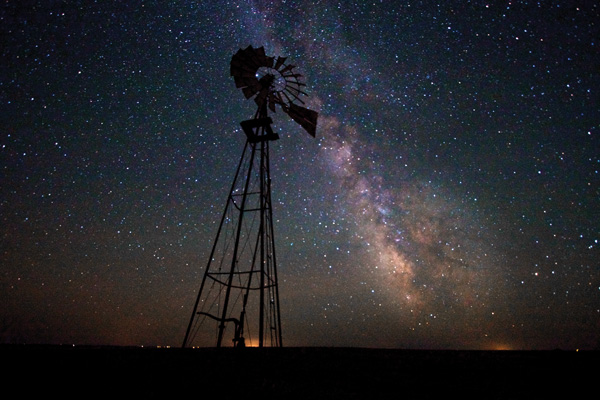 |
| Minimal light pollution in South Dakota allows stargazers to clearly see the Milky Way among thousands of stars. Photo by Christian Begeman. |
The night heavens have been a source of mystery and intrigue for millenia. The darkness, and what it contained, puzzled even the most brilliant Greek philosophers. “Astronomy?” uttered Sophocles in about 420 B.C. “Impossible to understand and madness to investigate.” But the last 2,500 years have given us rockets and rovers to explore distant planets, cameras that float to the outer reaches of our solar system and high-powered telescopes that allow us to see the faintest galaxies hundreds of thousands of light years away.
Stars, planets and other celestial bodies have fascinated me since I was 7, when an aunt and uncle gave me an astronomy book and a star wheel that showed various constellations in different seasons. I struggled with a tiny telescope to find the images I saw in the book. But beyond the Big Dipper, Orion the Hunter and other painfully obvious constellations, the results were disappointing.
Until last summer, the closest I had come to real stargazing was when a group of friends and I sat in the middle of a Hamlin County pasture with a case of beer on a cool, late autumn evening. I remember pointing out the Seven Sisters, the only name I knew at the time for the Pleiades, a blurry cluster of stars named for Greek mythological characters. My Coors consuming friends were not impressed.
Perhaps they didn’t realize that we were peering into some of the darkest skies found in North America. In 2001 well-known astronomer John Bortle compiled his Bortle Dark-Sky Scale. Its nine categories measure the level of darkness found in the sky. A color-coded map of the United States begins with black (the darkest skies) and ends with white, which represents inner-city sky. The eastern half of the country looks like a child’s finger painting. Blobs of bright green, yellow, orange, red and white dominate. But a line cuts the country in half, roughly along Interstate 29, where the bright colors abruptly end. Much of South Dakota is plunged into dark blues, purples and an inky dab of black over the Badlands.
On a typical evening, a glowing orange dome created by thousands of artificial lights encases Sioux Falls. But just 30 miles away you can clearly spot the Milky Way. I was amazed at its clarity when I attended the South Dakota Star Party at Hodgson’s Observatory 6 miles southeast of Beresford.
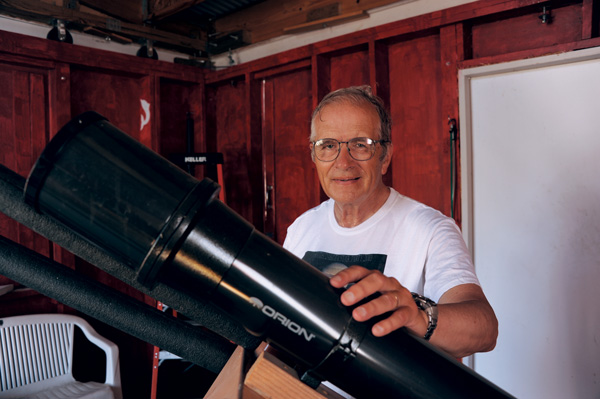 |
| Richard Hodgson hosts an annual stargazing party as his farm near Beresford. |
Richard Hodgson taught astronomy and planetary science at Dordt College in Sioux Center, Iowa for 30 years before retiring in 2002. He and his wife Nancy, a retired professor of archaeology at the University of South Dakota, bought their Union County farm roughly halfway between their respective schools in 1994 to create an observatory and host public gatherings.
“The Milky Way is just beautiful from this property,” Hodgson says. “It’s surrounded by bottomland which is farmed but not built on for a mile in various directions. It’s kind of like an island in the prairie. For eastern South Dakota it’s one of the better places to be.”
The Hodgsons began construction on the observatory buildings in 2003. The newest addition is the astrolodge, a small white classroom just south of their home where students and visitors first meet when touring the observatory. They get an introduction to the solar system through maps and a scale drawing. Another boxy building just four feet tall with a retractable roof houses a telescope used for solar observation. But the centerpiece is Hodgson’s 25-inch Obsession telescope (25 inches refers to the diameter of the mirror). It’s the second-largest telescope in South Dakota. Only Ron Dyvig’s 26-inch scope at his Badlands Observatory in Quinn, 6 miles east of Wall, is bigger.
Dyvig turned the tiny town’s abandoned hospital into an observatory in 2000. For years he was an avid asteroid hunter, searching outer space for Near Earth Objects on a potential collision course with Earth. During his research, he discovered 25 new asteroids in the main belt between Mars and Jupiter and three binary asteroids with small moons.
Today Dyvig’s telescope can be remotely controlled over the Internet. He’s helped students at the University of North Dakota earn master’s degrees by studying the universe through his scope. He also hopes to work with students at the University of South Dakota, South Dakota State University and the South Dakota School of Mines and Technology on a new research program involving supernovas.
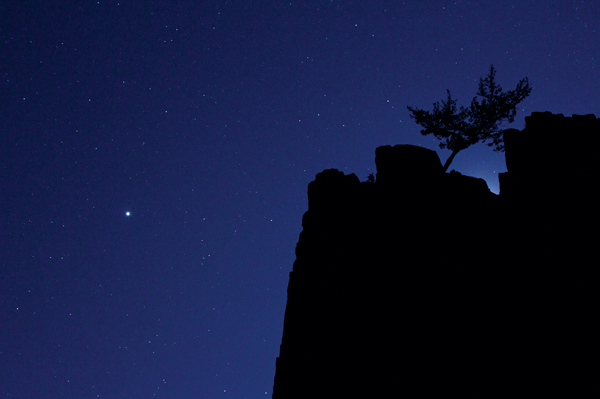 |
| South Dakota's Badlands feature some of the darkest skies in the nation. Photo by Christian Begeman. |
Another representation of the solar system at Hodgson’s Observatory follows a fenceline on the southern edge of the property. This scale model is 610 feet long (one of the largest scale representations of the solar system in North America) and includes plaques noting important objects. “We pick out things that are historically important, or unusual, or quite large and command some attention,” Hodgson says. “You can’t include everything in the solar system.”
Hodgson speaks with pride as we walk along the model, particularly when we arrive at 243 Ida, an asteroid whose orbit lies between Mars and Jupiter. In 1993 as the Galileo spacecraft snapped photos on its way to Jupiter, it discovered a tiny moon, later named Dactyl, orbiting the asteroid. The discovery justified research Hodgson conducted 40 years ago. “I’d advocated the idea back in the early 1970s, that some asteroids might have satellites, and this was laughed at by the scientific community,” he says. “By the late ‘70s there were a few others who thought it may be possible. But I was quite pleased that Ida came through for me.”
The late August morning dawned cloudy and rainy, but by noon the sun emerged. Amateur astronomers sweated through T-shirts as they assembled telescopes on three acres of grass that Hodgson cuts for members of the Sioux Empire Astronomy Club. John Johnson’s pickup was backed to a slab of concrete poured just for him. He was putting together his 20-inch Obsession telescope, the second-largest in use for that evening’s star party. “It’s a hobby, but some of us go a little crazier than others,” Johnson says. “I tell people that’s my Harley Davidson. I can put 350 billion light years on it and not even have to change the oil.”
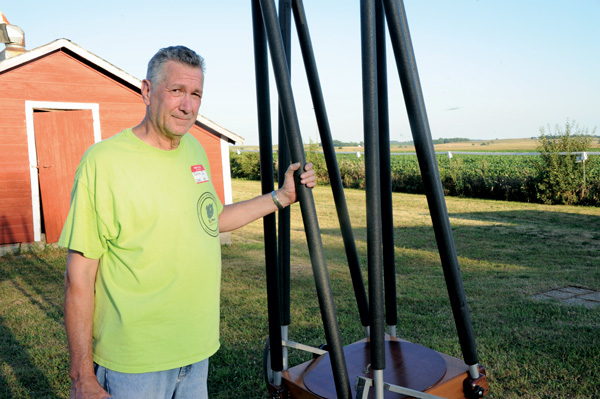 |
| John Johnson is a regular at Hodgson's star parties. There's even a slab of cement there for his telescope. |
Johnson works at Tendaire Industries in Beresford. He caught the stargazing bug 12 years ago. “When I was a kid I had a little toy refractor that was junk,” Johnson said. I could relate. “One day in 2000 I was walking through a pawn shop and saw a nice little box. It was a 60 mm refractor with all the eyepieces and the tripod. I bought it for $45, set it up in the backyard that night and pointed it at the brightest thing I could see. It happened to be Saturn, and I almost fell over. That was it. I had the fever.”
Next came a 4.5-inch refractor. Then a 6-inch. Then 8 and 10. “They call it aperture fever,” he says. “The more and more aperture you get, the more you see.”
Visitors arrived as dusk settled over the observatory, driving into the farmyard with headlights extinguished, which is proper stargazing etiquette. Hodgson began the night with a video in the astrolodge. Then attendees rotated among the dozen telescopes, guided by red filtered lights that illuminated the ground but did not hamper night vision.
The scopes were trained on star clusters, planetary nebula, comets and galaxies millions of light years away. The Andromeda galaxy, at 2.5 million light years from Earth, is about the farthest you can see with the naked eye. It was clearly visible, but even more spectacular through the scope. We observed the faint blues of the Crab Nebula and the bright green of the Dumbbell Nebula. Just before 10 p.m., the International Space Station cruised overhead. It was visible for about 90 seconds before disappearing in the eastern sky. Visitors left around midnight and club members were left to do their own observing until sunrise.
Thousands of stars were visible with the naked eye alone from Hodgson’s Observatory, but there’s even less light pollution west of the Missouri River. “I can tell you that South Dakota, if they had a ranking system [for states with the darkest skies], would rank quite high because we just don’t have light pollution at all compared to the rest of the country,” says Dyvig, the Quinn astronomer.
Conditions are even favorable on the outskirts of Rapid City, our largest West River metropolitan area. “We have, on average, 280 to 300 clear days every year, so we probably have better sky conditions than 95 percent of the rest of the country,” says Steve Parker, director of the Hidden Valley Observatory, headquarters for the Black Hills Astronomy Club, on the northwest edge of Rapid City.
But South Dakota’s very darkest skies are found over the Badlands. Stargazers may see a faint glow from a small town or the light from a ranch, but on a moonless night you can see up to 7,500 stars with the naked eye. “For people coming from big cities, it might be the first time they’ve ever seen the Milky Way before,” says Aaron Kaye, a supervisory park ranger at Badlands National Park. “On rare occasions, maybe 12 times in the 13 years I’ve been here, you can see the Aurora borealis. No promises, but we are far enough north that if the event is big enough we can see it.”
Stargazing is a hobby anyone can enjoy, especially in South Dakota, where light pollution remains minimal. And you don’t have to spend thousands on a telescope. It turns out, standing in a field with a guidebook works just as well. Either way, take time to look up. You’ll find that stars millions of light years away have never seemed so bright.
Editor’s Note: This story is revised from the March/April 2012 issue of South Dakota Magazine. To order a copy or to subscribe, call (800) 456-5117.





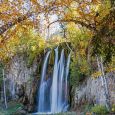
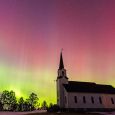



Comments
You and/or your readers may be interested to know that Badlands Observatory has recently opened to the public and is offering nightly stargazing tours. Details are at our website.